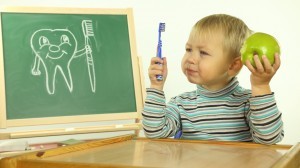You know that as your child grows, the baby teeth will fall out as the permanent adult teeth grow in. But, what happens when your child ends up with two sets of teeth — at the same time!? We know it sounds crazy, but as many as 1 in 10 children end up with adult teeth growing in behind their existing baby teeth. How does it happen, and what should you do about it? Let’s find out!
First things first: although this dental condition is sometimes referred to as “shark teeth” because of how sharks have two rows of teeth, children don’t actually develop a full set of adult teeth behind their baby teeth. Most commonly it affects only one or two teeth, usually the top or bottom incisors. The technical term for this is lingually erupting mandibular incisors, though in rarer cases it can affect other teeth as well.
What usually happens is that as adult teeth begin to erupt from under the gums, it dissolves or resorbs the root of the baby tooth on top of it. This causes the baby tooth to come loose and fall out, effectively allowing the adult tooth to push it out of the away and emerge in its place. However, in some cases, the adult tooth doesn’t develop behind the baby tooth and doesn’t dissolve the root as it begins to emerge. This causes it to erupt behind the baby tooth, leading to a child having both the baby and adult tooth at once.
In the majority of cases, the eruption of the adult tooth — even in the wrong place — will cause the baby tooth to loosen and fall out on its own. In this case, it’s best to let nature take its course, though your child can certainly wiggle that loose tooth to help it on its way! In some instances, however, the eruption of the adult tooth in the wrong place won’t cause enough of the root of the baby tooth to dissolve, so it doesn’t end up loosening and falling out. In this case, the pediatric dentist will either extract the baby tooth or perform a “disking” procedure, in which the enamel of the baby tooth is removed to allow more room for the adult tooth to fall into the right place and push the baby tooth out.
So, why would the adult tooth not grow in right underneath the baby tooth? Usually, it’s because there’s crowding in the jaw, which prevents the adult tooth from growing in the proper place. It can also just simply emerge in the wrong place for no discernible reason at all. Regardless, once the baby tooth is out of the way, the adult tooth will often migrate itself into the correct position. Sometimes, however, braces or a retainer are needed to align the teeth and correct any spacing issues.
Having an adult tooth grow in behind a baby tooth is usually nothing to worry about, but if the baby tooth hasn’t fallen out within a week it’s a good idea to see your pediatric dentist to determine whether extraction or disking is the correct course of action. It’s also good for the dentist to monitor the movement of the adult tooth to ensure it positions itself correctly. Teeth tend to have a domino effect on one another: a single misplaced tooth can cause the teeth on either side to fall out of alignment and can effect the eruption of other adult teeth. Spacing issues that are identified early are often easier to treat and prevent other issues from developing, so keep your dentist in the loop to ensure bright, straight smiles are in your child’s future.
“Shark teeth” might sound like a frightening phenomenon, but don’t worry — it’s very common and usually resolves on its own. Your child might even think it’s cool to have two teeth at once! Still, it’s a good idea to let your dentist know about the situation even if the baby tooth falls out quickly. Did you have one tooth grow over the other as a child? Let us know in the comments!








Leave a Reply